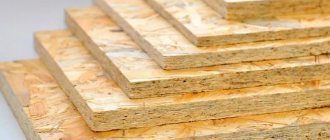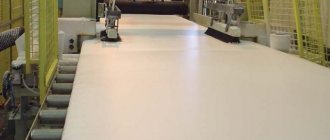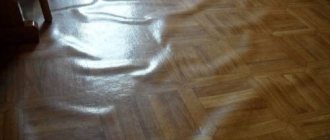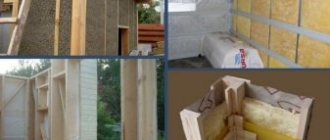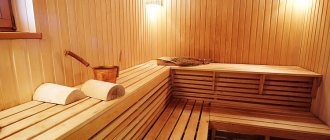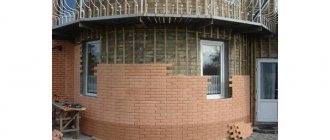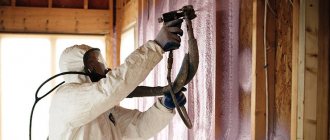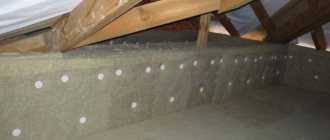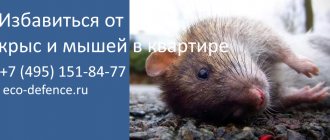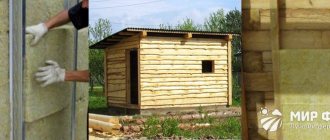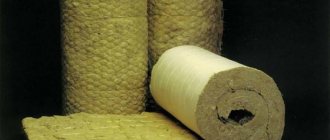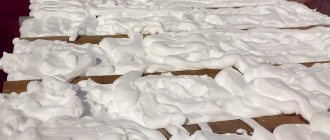What types of insulation do mice not eat?
The building materials market offers consumers a wide range of insulation materials.
And what’s important is that there are materials that mice won’t chew on. But if gray rodents already live in the insulation, then it will be very difficult to drive them out
Foam concrete
It is a rigid, but at the same time lightweight and porous thermal insulator. Rodents will not be able to chew holes in it.
Buildings made from foam concrete are very warm, durable and environmentally friendly for residents.
Please note: walls are insulated with foam concrete only from the outside, in order to avoid the formation of condensation and mold.
Expanded clay
Expanded clay is a very reliable, non-flammable and time-tested material. It is made from special types of clay. Granule sizes vary from 1 mm to 40 mm.
This insulation is used to insulate walls and floors. It is difficult for rodents to live in expanded clay. It is difficult to move there, there is not enough air, small parts can clog the respiratory system.
Ecowool
In the production of this insulation, orthoboric acid is used. The acid can cause lung damage, dehydration and even kill rodents. Ecowool is not a dangerous material for humans. Therefore, it can be used to insulate both external and internal surfaces.
The insulation has excellent functions of heat and sound conductivity, fire safety. The service life is at least 50 years. Ecowool is not subject to decomposition and rotting processes.
Foam glass
One of the materials that rodents do not like and therefore do not grow indoors is foam glass. It is produced by foaming glass and soot.
The thermal properties of the insulation do not deteriorate throughout its entire service life.
It is worth considering: to prevent mice from getting into the house, it is necessary to use high-quality cement mortar and take care of the tightness of the seams by treating them.
Which insulation materials are susceptible to rodent teeth?
During the construction and insulation of premises, materials with excellent thermal insulation properties are used. However, there are reviews from builders and home owners confirming that insulation materials have disadvantages.
Penoplex and extruded polystyrene foam are high-tech materials. They are used in industrial and civil construction, when laying railway tracks, highways and runways. These materials have high density. Therefore, rodents will not make their homes in it, but they can chew through it.
Basalt, mineral wool and glass wool are also unstable materials for damage by mice. In search of food, rodents will make holes and passages in mineral wool. This soft material will not stop small pests.
Watch the video in which a specialist explains which insulation is best to choose to prevent mice from getting in:
Do mice eat penoplex?
Penoplex is a modern insulation material for houses, apartments, and public buildings. Produced by extrusion using special equipment. It is a porous material with good thermal insulation properties. Insulation of facades must be reliable and of high quality. Rodents, which, with the onset of cold weather, make their way into a person’s home can nullify all efforts. Almost everyone is interested in whether mice chew penoplex. Because the material attracts with its excellent properties and low price.
The attractiveness of insulation for rodents
The structure of mice and their digestive system are designed in such a way that the animals do not tolerate hunger well. A mouse without food dies in 3 days. Therefore, the pest gnaws everything in its path - edible and inedible, healthy and not so healthy. The main thing is that the “food” fits the teeth.
After an invasion of mice, spoiled food containers, plastic products, rubber, wood, and burlap are discovered. Polystyrene foam, due to its porous structure, is easily susceptible to the teeth of mice. The question arises: do mice eat penoplex? Penoplex and mice There is nothing useful in the composition of the material for insulating a house. The insulation does not attract mice as food. But it’s great for building a nest, making passages, and tunnels for moving around the house.
Mice do not eat Penoplex. You don’t have to worry that your apartment or house will be left without insulation over the winter. But the integrity of the structure is undermined and the thermal insulation properties are violated. To restore insulation, physical, material, and financial costs are required.
Realities of life
You can ask eyewitnesses whether mice chew penoplex. The material has long been used as insulation, and there is experience in using it. Reviews are left on forums where such issues are discussed.
We decided to insulate the house. The work was done by specialists. Penoplex was used as insulation. With the first frost, mice began to sneak into the house. We noticed with horror that sounds were coming from the walls. The husband tore off the lower part of the insulation and discovered numerous passages. It is unclear whether they eat penoplex and other types of it, but they gnaw 100%.
Pest protection
Getting rodents out of your home is quite difficult. Especially if the mice are in the wall, where a person cannot reach without much effort. The use of poison for mice is fraught with an unpleasant odor in the house. Because the animal can die in its hole, which it built in penoplex. It will take a long time to catch with mousetraps and traps. Therefore, care must be taken to protect the penoplex at the stage of its fastening. Rodent control House and field mice make their moves in the lower part of the building. To protect the wall from gnawing, you need to build a protective structure in this place from a metal mesh, sheet, or durable material. Additional measures to increase the strength of the structure will protect against pests and guarantee durability. If you find out which insulation is not chewed by mice, you can use it without fear.
If mice have already infested the penoplex, you must:
- Get rid of mice in the house by any convenient means and methods;
- tear off the lower part of the insulation, check for pests;
- change the foam layer and restore the structure;
- protect the wall according to all the rules.
Rodents often live in private homes, but they confidently make their way into apartments in multi-story buildings. They live in the walls, in the attic, under the floor. A layer of insulation with flaws and errors creates better living conditions for pests.
Penoplex does not pose a risk to the health of rodents. Pests willingly construct entrances and exits in it, build holes, and live throughout the cold season. Gnawing through the porous texture is not difficult.
Rodents get into the narrowest cracks, small gaps. Wall insulation must be carried out in compliance with all reliability rules, taking into account future risks.
Penoplex45
This type is widely used not only in private construction, but is also in demand in the construction of roads, runways and airfields, since its density of 45 kg/m3 is the highest. These panels provide reliable freeze and thaw protection, resulting in a smoother finish and reduced damage. Children's playgrounds and even parking lots should be created by constructing roofs on them designed for heavy traffic.
Manufacturers and dealers constantly talk about the safety of materials, but is this true? Is foam complex harmful to health?
Many argue about the environmental friendliness of this material and claim that it itself has fire-retardant properties and is subject to combustion. It is impossible to argue because many people cannot resist the fire of objects around us.
Whether it can ignite itself or contribute to a fire is another matter. The question is clear - no. But at the moment of ignition it produces a lot of corrosive smoke and releases toxic substances. However, it burns slowly, so it will take some time before it burns and the fire can be extinguished in time.
Another disadvantage that negatively affects the human body is the destruction of the material that occurs under unfavorable operating conditions. Penoplex not only loses its properties, but also oxidizes and begins to release toxins into the air. This happens when low-quality products are selected or installation rules are violated.
Therefore, it is important to choose only those materials that are produced using this technology, follow the installation rules and not use incompatible connections. Only under these conditions will it serve its purpose without causing harm to humans
About penoplex
There are many types of insulation, each of which has its own pros and cons. Penoplex is an extruded material. The extrusion method is simple. Under the influence of high temperature, under strong pressure, granulated polystyrene is foamed, from which smooth slabs are then made. This is a finely porous material in which cells isolated from each other are located. They are filled with air.
Why do many people choose penoplex for building a country house? Advantages of this material:
- It's inexpensive.
- It is particularly durable and reliable.
- It has a reduced level of thermal conductivity, so penoplex is better than many insulation materials.
- It prevents the penetration of moisture; just 2 cm of this insulation has the same vapor permeability as roofing felt. But it absorbs moisture where the cut is located, because at this point the cells lose their integrity.
- This material does not rot or decompose, there is no mold in it, i.e. it is biostable. But, despite this, it is highly environmentally friendly, although some disagree with this statement. If there is a fire and the material catches fire, harmful substances are released. But penoplex cannot ignite on its own. It is easy to cut and can be installed regardless of weather conditions.
- It lasts, taking into account various influences, fifty years. But studies have been conducted in which the material was frozen and then thawed. Even in such harsh conditions, it held up and confirmed its warranty period with a margin.
- Does not dissolve, does not change shape if exposed to alcohol-based paints, chlorine, cement mortar, etc.
In order for these beneficial properties to be preserved, it is important to buy high-quality products and carry out installation correctly. If these conditions are not met, it loses its properties, oxidizes and even releases toxins
Penoplex has been serving the home owner for 50 years or more.
There are several types of penoplex, which differ from each other in various characteristics. There is a Penoplex Foundation, with special strength. The penoplex wall is made with fire retardants, so this material will not immediately ignite. They rarely insulate the inside, unless it is difficult to do it outside. If you work with it indoors, choose thinner slabs to make it easier to work with. There is also Penoplex Roofing, which can withstand heavy loads. Such a roof will last a long time, even if it is a flat version, and then a flower garden was planted on it. There is also the universal Penoplex Comfort, which is used everywhere.
As an afterword
What can you advise the owners of dachas and country houses if they have a problem - mice chew on foam plastic (expanded polystyrene). First of all, don't panic. A mink discovered in time should serve as a signal for immediate action. Check your home regularly for rodents and be vigilant. This way you can avoid serious problems and equally serious costs.
Secondly, if you have the opportunity, when building a house and insulating it, do not forget to cover a layer of polystyrene foam with a protective fine-mesh mesh. This way you will protect the polystyrene foam not only from rodents, but also from birds, which can also cause damage.
Thirdly, take the advice of experienced homeowners and install an ultrasonic mouse and rat repeller. Believe that the costs will not be in vain and will more than pay for themselves. The device is not that expensive, it is quite effective and does not require special maintenance.
Don't forget about the cat. There may even be several of them if you have a large farm. Our grandparents always kept a cat in the house and were pleased with the result. Cleanliness is not only a guarantee of health, but also a guarantee of your quiet life in your summer cottage. Mice eat what you throw at them, they eat with appetite, they eat a lot - don’t forget about it!
In addition to the fact that they eat insulating material, they can infect you with some kind of infection (hemorrhagic fever, for example). Therefore, after exterminating mice, be sure to carry out thorough disinfection. It is better not to do this yourself, as there is a risk of poisoning from chemicals. There are specialized companies involved in pest control. They will efficiently destroy rodents and disinfect the area.
How to protect foam from mice?
Some researchers argue that foam boards can be protected from being chewed by mice due to the properties of the material itself. To do this, it is enough to increase the smoothness and density of the surfaces - roughness along the edges significantly facilitates the possibility of damage. But in practice it turns out that not everything is so simple. Therefore, the following methods are recognized as the most effective:
- — installation of reinforcing mesh;
- — use of ultrasonic repellers;
- - use of poisoned baits.
The secret to successfully using metal mesh lies in the way it is installed. Firstly, it should be fine-mesh no more than 8 by 8 mm.
Secondly, in order to isolate the polymer slabs from the penetration of mice, they must be fenced with a mesh to a height of at least 0.3 meters. At the same time, do not forget about eliminating all holes and cracks that could serve as loopholes for rodents. If they do not have the opportunity to get to the material, then they simply cannot spoil it. This method of protection is effective, but is only suitable for use during the construction stage. What to do if the house has already been built and problems with rodents begin?
Uz repellers
Another, no less effective way to protect polystyrene foam from mouse teeth is to install ultrasonic repellers in your home. These devices do not physically destroy rodents, but make their existence in the room simply unbearable.
The main part of any ultrasonic repeller is a high-frequency oscillation emitter - ultrasound. The frequency is selected in such a way that the human ear practically does not perceive it, just like the ears of domestic animals. But rodents hear even too well. For them, such radiation is like the roar of a jackhammer, which works non-stop around the clock. They are not able to endure it for long and, sooner or later, leave their habitable premises.
One of the most popular models of repellers is Tornado 400 (price from 2100 rubles)
For a private home or cottage, we can recommend the popular Tornado 400 repeller model, capable of covering an area of up to 400 m². The frequency it generates changes all the time. This prevents rodents from adapting to annoying noise. Ultrasound affects them constantly, no matter what corner the animals are in.
The GRAD A 1000 PRO repeller also gives good results. Apart from mice that live in foam, it can easily cope with almost all household pests because it has four operating modes. Features of this model:
- — six bright LEDs for increased efficiency at close range;
- — the presence of a completely silent mode;
- — an effect that eliminates “fading of oscillations”;
- — ability to adjust signal strength.
- the most important advantage is that the effective impact area is up to 1000 m2
Read reviews about the repeller and buy GRAD A1000 PRO
The compact RIDDEX device is very convenient. Its main difference is the combination of acoustic and electromagnetic effects. When turned on, the device additionally creates a force field that extends along the entire electrical wiring of the house.
- The cost of such a device is from 1400 rubles
Read reviews and order RIDDEX repeller with delivery throughout the CIS
Poisonous baits
From sellers of building materials you can hear about special types of foam and polystyrene treated with rodenticides. Maybe at first, while these materials are still new, mice will refuse to chew on polymer panels. But gradually the chemicals begin to break down or simply evaporate. Sooner or later the material will become completely harmless to animals. Maybe try to treat it with something yourself? Selecting the appropriate chemicals and then spreading them on a poorly absorbent surface will be very problematic.
It is much easier to use ready-made poisonous baits. The only condition is that they must have a mummifying effect, for example, like Storm or Goliath. Otherwise, the unpleasant cadaverous smell from rodents that have died in their nests will not be avoided.
Another tool that our readers recommend is the “Down with Uninvited Guests” set (set No. 3). The kit includes:
- 5 poisonous formulations of 100 g each with various attractive aromas;
- bait house;
- rubber gloves.
- The cost of the set is from 390 rudders
According to user reviews, such a set is enough to kill rodents in the house and surrounding area with a total area of up to 250-300 m2.
And for those who have tried all the methods and did not get the desired result, or simply do not want to deal with unfamiliar equipment or toxic substances, we can recommend contacting a pest control service. Experienced specialists will tell you what to do to prevent mice from chewing the foam, and will carry out all the necessary treatments using the most modern drugs.
“If you please, another time” - insulation materials that don’t bite
For one reason or another, the insulating materials listed below are not interesting to rodents:
Concrete-based materials benefit from strength. Ecowool contains orthoboric acid, which is added to the composition so that the organic insulation does not rot. This is what protects the material from pests.
So, at the beginning of the article we were faced with three tasks: to find out what can be used to insulate a house so that mice and other rodents cannot grow in the insulation, how to process the material so that it is not interesting to mice, and how to remove pests if they are already visiting. We noted that:
- Mineral wool and polystyrene foam are attacked;
- A fencing structure needs to be built around the insulated area - for example, polystyrene foam can be plastered without leaving even a small gap;
- Material treated with insecticides or orthoboric acid repels pests;
No matter what the material is treated with, mice will definitely not appear in the insulation only if it is covered with a protective layer. The material thus protected will properly serve its intended purpose.
I wish you good construction and only invited guests to your house!
What is foam insulation?
Disadvantages and advantages of foam glass
Dowels for attaching insulation. 3 types, 3 mounting options
Which insulation doesn't breed mice?
Above we looked at the most popular materials for insulation and found out that all of them are not an obstacle to small pests. But science does not stand still. Materials that are not so easy on the teeth of mice and rats have begun to appear on the market.
At the same time, many characteristics of insulation have been improved.
What are these new generation materials? These are insulation materials such as ecowool, foam glass, expanded clay. Let's start the review with ecowool. This is an insulation material created on the basis of cellulose with the addition of antipyretic and antiseptic agents. It can be assumed that rodents will like such soft and warm material, but the secret is that during the production of ecowool, orthoboric acid is added to the composition, which is completely harmless to humans, but causes persistent suffocation and dehydration in mice and rats.
Its advantages:
- Excellent thermal insulation ability;
- Low breathability;
- High coating density;
- Fire safety;
- Moisture resistance;
- Easy to use and durable;
- Completely harmless to humans.
No less interesting in terms of the issue under consideration is such a relatively new insulation material as foam glass. It is produced by manufacturers, both in slabs and in loose form. It is made by melting glass and then foaming it. This material is very durable, so neither mice nor rats can chew it. It does not matter in what form the foam glass is: in blocks or in bulk. On top of that, in the bulk version it is also quite difficult for mice to move. Along with the above-mentioned strength function, which does not allow small pests to gnaw and settle inside this thermal insulation material, it has all the same characteristics as ecowool with a difference in coefficients and composition.
To prevent mice from getting into the insulation, it should be tightly covered with finishing materials
Expanded clay insulation, which has long proven itself in construction, is at the same level as foam glass and ecowool, although it is not one of the new products on the market. This is a porous material obtained by firing special types of clay. It is produced both in the form of large granules, similar to gravel, and in the form of sand. But expanded clay is much lighter than them, since during the firing process maximum moisture evaporates from it. In addition to high thermal insulation characteristics, this heat insulator has excellent noise-absorbing properties; it is also very durable, capable of withstanding mechanical loads. It is for the latter reason that expanded clay is inconvenient for mice and rats to live in the thickness of the insulation. In the fine fraction of expanded clay, rodents will simply drown, they will not have enough air, and due to its special hardness, it is not suitable for the teeth of pests.
What is the attractiveness of the material
But really, why do mice chew foam? There are at least five reasons for this.
- Everything is elementary. A plastic material with excellent thermal insulation properties is ideal not only for insulating a human home, but also for arranging rodent nests, where they settle without a twinge of conscience. Other building materials have similar properties: penoplex, expanded polystyrene, which mice gnaw for the same purpose.
- Even if the gray animals do not intend to live in foam plastic, they will still use it to create their own labyrinth. Well-trodden paths are corridors along which you can walk without fear between the nest and the kitchen or pantry, where many tasty and edible human supplies are stored.
- The constant growth of the incisors causes the animals to gnaw on surrounding objects.
- House mice can damage material in stressful situations: for example, during strong noise, as a result of a sharp increase in the number of individuals in the population, when the struggle for food and shelter begins.
- Exploratory behavior: It has long been proven that when they come into contact with something new and unknown, rodents try to try an unusual object on their teeth.
Why do mice need foam?
Rodents have a special tooth structure. On the upper and lower jaws there are a pair of incisors, which appear closer to 20 days after birth and grow until the end of life. Teeth grow by 1 mm per day. If you don't do anything about it, the mouse simply won't be able to close its mouth.
Mice also chew foam for some other reasons:
- In a stressful situation. When there is a lot of noise in the room or there is a struggle for survival, habitat. Rodents mark their territory in this way and calm their nerves.
- Innovation. The mouse tastes all unknown materials. Rodents will not eat useless “food”, but will use it for other purposes.
- Building material for the nest. Not only people, but also mice appreciated the properties of polystyrene foam. Non-toxic, easily separated into pieces, has high thermal insulation. Mice build their nests directly in the thickness of the foam, gnawing numerous passages there, or bite off parts and drag them to a more convenient place for them.
Styrofoam and mice
Foam in the walls separates the outside of the building from the inside. Trying to get into the room, mice gnaw everything, assessing its hardness. Seeing that the material lends itself well, the animals firmly achieve their goal. Some kind of flaw in the construction. Allows pests to enter the house almost unhindered.
Mice and penoplex
Mice are animals that will chew on almost anything that can bite their teeth, and they are a potential hazard to almost all heaters. The foam complex, although it does not contain edible ingredients, is quite soft and has a porous composition, so it is not difficult for small pests to fight it.
Animals try to get indoors to escape the cold and humidity or to find something to eat. Mice can tunnel through them to get what they want, causing their insulating properties to plummet. This is confirmed by reviews from rodent victims.
What kind of insulation do mice and rats like?
All thermal insulation materials can be schematically divided into two groups. The first includes insulation materials that rodents use as nests or for boring teeth. The second group includes building materials that are of absolutely no interest to rodents.
If you plan to use insulation from the first group, then you should take care of their additional protection.
The main parameter by which rodents choose housing for themselves is that the material must have low density, be warm and dry
The insulation materials favored by rodents include:
- Styrofoam;
- Pepoplex;
- Mineral wool;
- Chipboards;
- Penoizol.
Styrofoam
Polystyrene foam is most often used when carrying out work on insulating premises. This popularity is due to the lightness of the material, affordable cost and does not cause problems during installation work. Rodents also loved the material.
If rodents get into your home, the foam may not be enough for several seasons
The animals will gnaw through the insulation and then arrange a place for their home. In addition, rodents crumble the material into small fractions and use the pieces to insulate their nests.
Some owners of private houses try to fight pests by placing various poisons directly under the cladding. This method of control is quite controversial, since the rodent can die right in the insulation, and the decomposing body will cause an unpleasant odor in the house. To remove the corpse, you will have to dismantle the structure.
Penoplex
Extruded polystyrene foam is a modern version of conventional polystyrene foam. It differs from the base material in improved resistance to high air humidity. The material is used for insulation of residential and industrial premises. It is widely believed that due to its high density and strength, rodents avoid it, but this is not true. Mice and rats destroy polystyrene foam no less readily than regular polystyrene foam.
Penoplex, like foam plastic, is not eaten by rodents, but they use the material to build a nest.
Rodents do not eat Penoplex, but they violate its thermal insulation properties.
Remember that penoplex whose integrity has been compromised almost completely loses its thermal insulation characteristics, and restoring the insulation will require significant physical and financial costs from the home owner.
Mineral wool
Despite promises from manufacturers that rodents do not use mineral wool to build their nests, using insulation will not help protect your home from pests.
Rodents not only use mineral wool to build their homes, but also live in this insulation much more often than in many others. Experts have found that in mineral wool, rodents create the most optimal and closest to natural conditions for permanent residence.
The material has enormous advantages over other insulation materials, but resistance to rodents cannot be considered one of its advantages.
Mineral wool has excellent soundproofing characteristics, so you won’t even hear rodents inside
Chipboards
If you decide to insulate your house with chipboards, then you should think in advance about how to protect the material from rodents. Like all similar materials, chipboards are made of wood, and therefore will not become a serious obstacle to entry into the home for mice and rats.
Penoizol
There is an opinion that, unlike polystyrene foam, the liquid material penoizol is too tough for mice and rats, but this is a fairly common misconception.
You can do a simple experiment - just seal the mouse hole with this insulation and wait a while. The material will not become an obstacle in the path of the rodent, since very soon a hole will appear in it.
The sheathing creates passages for quick movement around the house. It is interesting that rodents also do not use penoizol to furnish their homes, preferring other materials.
Which insulation doesn't breed mice?
Above we looked at the most popular materials for insulation and found out that all of them are not an obstacle to small pests. But science does not stand still. Materials that are not so easy on the teeth of mice and rats have begun to appear on the market.
At the same time, many characteristics of insulation have been improved.
What are these new generation materials? These are insulation materials such as ecowool, foam glass, expanded clay. Let's start the review with ecowool. This is an insulation material created on the basis of cellulose with the addition of antipyretic and antiseptic agents. It can be assumed that rodents will like such soft and warm material, but the secret is that during the production of ecowool, orthoboric acid is added to the composition, which is completely harmless to humans, but causes persistent suffocation and dehydration in mice and rats.
Its advantages:
- Excellent thermal insulation ability;
- Low breathability;
- High coating density;
- Fire safety;
- Moisture resistance;
- Easy to use and durable;
- Completely harmless to humans.
No less interesting in terms of the issue under consideration is such a relatively new insulation material as foam glass. is produced by manufacturers, both in slabs and in loose form. It is made by melting glass and then foaming it. This material is very durable, so neither mice nor rats can chew it. It does not matter in what form the foam glass is: in blocks or in bulk. On top of that, in the bulk version it is also quite difficult for mice to move. Along with the above-mentioned strength function, which does not allow small pests to gnaw and settle inside this thermal insulation material, it has all the same characteristics as ecowool with a difference in coefficients and composition.
To prevent mice from getting into the insulation, it should be tightly covered with finishing materials
Expanded clay insulation, which has long proven itself in construction, is at the same level as foam glass and ecowool, although it is not one of the new products on the market. This is a porous material obtained by firing special types of clay. It is produced both in the form of large granules, similar to gravel, and in the form of sand. But expanded clay is much lighter than them, since during the firing process maximum moisture evaporates from it. In addition to high thermal insulation characteristics, this heat insulator has excellent noise-absorbing properties; it is also very durable, capable of withstanding mechanical loads. It is for the latter reason that expanded clay is inconvenient for mice and rats to live in the thickness of the insulation. In the fine fraction of expanded clay, rodents will simply drown, they will not have enough air, and due to its special hardness, it is not suitable for the teeth of pests.
If they already live?
In this case, you should not hope that the rodents will go away on their own. You need to get rid of mice and other rodents in two stages. First of all, you need to eliminate the source of their appearance. Perhaps it's a trash can that may be causing mice to live near the house, or unopened edible supplies in the house. In general, everything that pests can drink.
When the source is eliminated:
- Disassemble the insulating pie;
- Remove damaged parts;
- Restore the insulation layer;
- Make sure you're protected for the future.
Although, it is clear that there cannot be any miracle solution to the problem. Therefore, many decide either at the replacement or construction stage to choose one of the options that is not interesting to pests.
How to restore and protect polystyrene foam
Before you begin restoring the insulating material, you need to get rid of all rodents. If necessary, you can dismantle the bottom layer to assess the damage.
In case of major damage, you need to completely get rid of all the sheets that were damaged and install new ones. You just need to do this with mesh reinforcement.
When the damage is not large and dismantling the slabs is not required, you can simply use a base profile or a special mesh. The market is very extensive and you can easily find exactly the mesh that will serve as a barrier for rodents. If you still cannot find a suitable mesh, you can use a regular metal mesh.
Attention! It is imperative to ensure that the cells are as small as possible. The best, in this case, is aluminum mesh.
Types of insulation that mice do not eat
On the modern building materials market there is a huge number of different insulation materials in which rodents are not able to grow. So, what kind of insulation do mice not eat?
- Foam concrete. This material is environmentally friendly, lightweight, porous and rigid. Animals simply cannot gnaw a hole in it. Structures made of foam concrete are warm, reliable, and durable.
- Expanded clay. The material is durable and practical, not subject to combustion. It is made from special varieties of clay. The structure of expanded clay consists of small granules, the sizes of which reach 1 – 40 mm. The insulation is mounted on walls and ceilings located between floors. It is quite problematic for mice to live in such material, since there is not enough air there, and small particles can enter the respiratory tract of the animals.
- Ecowool. The production of such material involves the use of orthoboric acid, which leads to lung damage, dehydration and death of parasites. The insulation is completely safe for humans, therefore it is used to insulate internal and external surfaces. Ecowool retains heat well, does not burn, and lasts more than 50 years. The material does not rot, does not decompose, and does not emit toxic substances.
- Foam glass. This is another insulation that rodents will not eat. It is made from carbon black and foam glass. The positive properties of the material do not deteriorate even after prolonged use.
Resistant seals
In fact, rodents practically do not eat insulation materials; they only make passages in them. During construction, home owners insulate the floors and walls. If rats or mice decide to settle in such a space, it will be extremely difficult to evict the pests, so it is best to find out in advance which insulation does not allow rodents to live in.
Smooth expanded clay
Expanded clay is a material made from clay by firing at high temperatures. It has a porous structure, lightness and smoothness. This insulation has excellent thermal insulation properties and an affordable price. There are several pest-resistant varieties of expanded clay that are used for home insulation:
- Gravel. The most common type of expanded clay. Pellets can be either oval or round in shape.
- Crushed stone. This material consists of parts of pellets and has sharp edges. It can very often be found in concrete.
- Dropout A good fine material obtained from waste as a result of crushing or roasting.
Rodents do not chew some types of expanded clay
. Expanded clay is a good environmentally friendly material with low toxicity. Rodents avoid it for several reasons:
- The coolant is round and mechanically dense, which is unpleasant for the teeth of pests.
- The compactor will shrink, making it very difficult to dig passages and make holes in it.
- There is too little empty space in such material (especially in screenings and crushed stone), so rodents will not have enough air.
Durable foam glass
Foam glass began to be produced back in the USSR. At first it was used in floating structures, but then it became known that it has excellent thermal insulation properties. This material is created from glass waste and is produced in the form of slabs and bulk material. The slabs hold plaster and glue well, they can be sawed and laid on cement mortar.
This material has a lot of advantages
The seal is quite expensive, but has many advantages. The following advantages can be highlighted:
- pest resistance;
- amazing durability (can be used for up to 100 years);
- does not shrink or shrink;
- high strength, rats and mice cannot figure it out;
- lack of microflora necessary for the development of fungi and insects.
In this video you will learn how to choose insulation:
Safe ecowool
Cellulose insulation is also not suitable for rodents. This material is made from paper waste and impregnated with fire retardants and antiseptics. Unlike ordinary glass wool, ecowool does not lose its qualities when in contact with water. The main advantages of ecowool:
- fire resistance;
- seamless installation method;
- excellent thermal insulation;
- high-quality sound insulation;
- environmental friendliness and safety.
Although ecowool is one of the most environmentally friendly materials, rats and mice are in no hurry to settle in it. During the production of this sealant, it is treated with orthoboric acid. This substance causes rodents to lack air and become extremely thirsty, so they immediately leave the area.
This insulation is very easy to install
Fire-resistant foam concrete
Foam concrete is highly reliable and has a long service life. This is a very durable material that is not subject to combustion. It is able to accumulate heat and normalize the level of moisture in the room. In addition, foam concrete has the following advantages:
- ease of installation and processing;
- good sound insulation;
- environmental friendliness;
- possibility of laying blocks on glue;
- fire safety.
Stone strength makes the seal one of the most resistant to rodents. However, during operation, microcracks appear in it, in which insects can settle. Also, this material does not like moisture very much: contact with water can lead to the formation of mold, a vapor barrier is necessary. In addition, foam concrete is quite difficult to plaster.
Reliable penoizol
Penoizol is a high-quality and durable sealant. It is designed for at least 50 years of operation without loss of basic properties. The material also has other advantages:
- resistance to temperature changes;
- ease of installation;
- good thermal insulation;
- fire resistance;
- environmental cleanliness;
- resistance to fungus and mold.
When not yet hardened, the sealant has good fluidity, so it can easily fill various openings and cracks in the building. Rodents are not attracted to penoizol because it contains formaldehyde, which is used as an antimicrobial agent, and fine dust, which causes suffocation in rats and mice.
Protecting foam from pests
Polystyrene foam is a very convenient material for thermal insulation and sound insulation. But it is various foam plastics that are most susceptible to attack by mice and rats. These are materials such as extruded polystyrene foam, polyurethane foam, penoizol, penoplex. These materials are artificial, so they are not suitable for mice as food, but they chew them and turn them into dust. In the resulting voids, rodents make nests for themselves. To protect it from rodents, you need to take certain measures:
- It is necessary to choose dense types of polystyrene foam for insulation, since it is inconvenient for mice to gnaw on dense material.
- Proper installation of the foam is necessary. It must be carefully puttied and sheathed using special materials, selected individually. The goal of proper installation is to prevent the appearance of cracks, since rodents enter the home through the cracks.
- All holes must be sealed with foam.
- It is advisable to provide metal sheathing along all walls at pest entry level. They won't be able to handle metal.
These measures must be taken into account at the construction stage. If they have not been accepted, all that remains is to take actions aimed at repelling rodents:
- The easiest way is to get a cat. Just the smell of a cat in the house repels mice.
- You can install an electronic repeller, but if the area of the house is large, one device will not be enough, you will have to install several. Such repellers emit ultrasound of various frequencies, which causes fear in rodents and forces them to leave the building.
- All food supplies must be kept out of the reach of rodents.
- The home must be kept clean.
Folk remedies are effective to protect polystyrene foam. They are based on the use of various plants that repel rodents with their smell. These are plants such as pine needles, tobacco, mint, wormwood. These dried plants can simply be scattered in corners. During the construction phase of a house, you can treat the foam with lime or red pepper.
Some people use boric acid to repel pests, but its effectiveness in controlling rodents has not been proven.
If none of the above methods help, you need to contact the sanitary and epidemiological station, whose employees will come and carry out a complete disinfection of the premises and the elimination of all rodents.
Source: svekrovi.net
Do mice chew polyurethane foam?
To avoid such a problem, you need to take care of this at the stage of building a house when choosing insulation. Let's do a little research and study the insulation materials currently on the market.
Let's take a look at the list of the most popular materials for protecting your home from cold and moisture:
- Polystyrene foam, extruded polystyrene foam, polyurethane foam, penoplex;
- Mineral wool, glass wool;
- Ecowool;
- Foam concrete, aerated concrete;
- Expanded clay;
- Foam glass.
The most remarkable thing is that any insulation is inedible for mice and rats, but setting up a comfortable and warm hole with a network of passages to it in some of them is just right. Now everything is more detailed. The most affordable and widely used insulation material in everyday life, both by professionals and ordinary citizens, is polyurethane foam.
Polyurethane foam is a polyurethane foam sealant in aerosol packaging, sold in any building materials store.
It has properties that have long been positively assessed by builders - sound insulation, heat insulation, installation (sealing, connecting, fastening), ease of use (does not require expensive devices for application).
How to protect insulation?
Essentially, there are two ways to protect thermal insulation from pests:
Moreover, it’s worth mentioning right away that the first method is as reliable as a tank. The second is more of a temporary measure in case of storing unused material, although it is also used in finished structures.
Styrofoam and mice. If you build a concrete structure around a heat insulator, for example, polystyrene foam, which will protect it, no pests will most likely try to gnaw through it. For example, such types of finishes as “bark beetle” are not chewed by mice and rats very often.
Rodents are becoming a big problem for owners of frame houses. The frame essentially consists of insulation, and it can be protected with reinforced mesh with a very fine cross-section.
Among the chemical remedies, folk remedies can be noted, such as:
Insulation with protection against rodents. There are cases when, before insulation, foam plastic is treated with lime or even pepper. But in fact, only insecticidal products specifically designed to control pests can help.
By choosing the second method (chemical agents) to protect the insulation, you agree with all the disadvantages and side effects of the poison. And here it’s up to someone to decide: if someone doesn’t even use polystyrene foam because of its harm to health, most likely only the first of two methods will suit you.
How to protect an insulated house from rodents
It makes no sense to talk about how to get rid of mice using rat poisons and all sorts of mousetraps, especially when they live in the thickness of the outer walls. The best way to preserve the integrity of the thermal insulation structure is to keep the mouse out of the house, although a 100% guarantee cannot be achieved. What is recommended to do:
- Try to build houses from warm structural materials - aerated concrete or wood concrete. If you maintain the required wall thickness, you will not have to insulate them.
- To insulate roof slopes and ceilings, use dense basalt wool or fill the attic with expanded clay.
- To protect polymer and other soft insulation materials, the foundation and base of the house must be enclosed in a fine steel mesh coated with zinc.
- Make a basement ebb in the form of a metal canopy around the perimeter of the building. It will prevent the mouse from climbing up the wall to the roof.
- Install an ultrasonic repeller in the attic.
Such an overhanging canopy is quite difficult for animals to overcome
Also, do not refuse the help of your smaller brothers - domestic cats. For a successful hunt, they need to provide access to closed cavities, the attic and basement, not forgetting to remove all mousetraps. More information about protective equipment is described in the video:
How to avoid trouble and protect your home
The following rules must be adhered to:
Get a cat or cat. You can adopt a kitten from the street or a hunting breed, such as an Abyssinian. The desired color of the animal is striped or motley. The smell of a cat will repel rodents. It is necessary to keep food out of reach, do not leave leftover food on the table, and regularly thoroughly clean the rooms. Foam plastic must be installed according to all rules
Mice and rats enter the house through cracks, so it is important to use foam to seal them. Also carefully putty the polystyrene
And then sheath it using special building materials. To guarantee, all walls should be covered with fine mesh. Rodents certainly cannot damage metal. Dense types of insulation and durable cladding material are also difficult for mice. At the time of construction of the house, it is worth laying a strip foundation. It forms a contour of reinforced concrete beams. Place broken glass around the perimeter. The poison for gray pests is boric acid. It is scattered near burrows and around the perimeter of housing. However, if there are animals or children in the house, acid is prohibited from use.
Folk remedies include the use of the following plants in dry form: wormwood, chamomile, wild rosemary and elderberry. They are put in bags and placed in the corners of the house and places close to the habitat of mice. It is worth installing an ultrasonic repeller. The sound produced by this device has a negative effect on rodents. The number of devices directed against mice depends on their range and the area of the house.
Why do pests get into the house?
To begin with, it would be a good idea to understand how mice and rats behave and what guides them when entering a person’s house.
To protect the foam from mice, it should be kept away from food.
So, the main goal of rodents is to search for food.
They will never chew something just like that, especially without the hope of finding something edible there. And they don’t care at all what material gets in their way. It may not be foam plastic at all, but something else, for example, mineral wool or any other insulation.
In this case, it is important that it is located in close proximity to the walls, and it is from the street that such hated rodents most often enter the home. By the way, they never move alone. And therefore it is worth preparing for a whole invasion.
Rats are more intelligent in this sense. So, to reconnoiter the situation, they send a so-called “messenger” (this may be a weak individual from the entire flock, which they would not mind losing). At this moment, a person should be wary, because where there is one rodent, there are a dozen.
It is also important to understand another instinct of mice and rats: they simply love to stockpile. This is inherent in them by nature. And therefore, in walls insulated with foam plastic or anything else, pests can simply store their prey.
That, in turn, will eventually begin to rot and poison not only the life of the owners of the house, but also the air in it. The most unpleasant phenomenon is dead specimens, into whose stomach this heat-insulating material accidentally disappeared. It is not difficult to imagine what consequences will arise in this situation.
You can avoid all of the above troubles if you follow the rules and tips that will be offered below.
Return to contents
There are several proven tips that will help you forget about the problem of pests where there is the previously mentioned material as insulation.
The foam must be thoroughly puttied, then coated with a protective agent.
So, you need to safely hide all edible supplies. They must be located in a place where only human access is possible. Neatness in your home is also very important.
As for the purely technical aspect of the issue, the correct installation of the foam is important. It must be carefully puttied and sheathed using special building materials suitable for each individual case. The most important thing is the complete absence of cracks.
There will be no cracks - there will be no rodents. After all, it is through them that penetration occurs. To seal the holes, it is necessary to additionally use polyurethane foam.
For greater confidence, metal sheathing can be installed along the entire perimeter of the walls at the level where pests enter. They certainly won't be able to defeat metal.
The traditional method of control is the use of boric acid. However, it has not been proven exactly how effective it is against uninvited furry guests.
In conclusion, it can be argued that the main solution to protecting polystyrene foam from rodents is to seal the cracks. And those who do not trust any of the proposed methods can simply get themselves a cat. Successful rodent control! And let the protection be reliable.
- Date: 08/26/2015 Rating: 36
Polystyrene foam is a very popular material in construction and renovation. This material was discovered in the middle of the last century.
Polystyrene foam production diagram.
Until now, foam plastic is not going to go into oblivion, despite the fact that many valuable materials have appeared that can compete with it.
Most often, polystyrene foam is used for thermal insulation of rooms. Its soundproofing properties are also good. But today we will not talk about the scope of application of polystyrene foam.
Next we will talk about how to protect polystyrene foam from the negative effects of rodents. After all, they can penetrate the wall and chew through it, which leads to unsanitary conditions.
